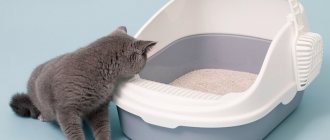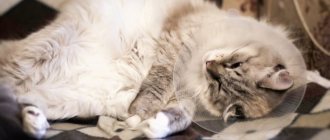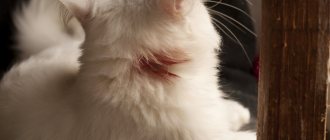8112Administration
Sterilization of cats by puncture is a fairly common type of operation, which has opponents and supporters. The purpose of the operation is to reduce the animal’s sexual activity, as well as to stop the reproduction of offspring. Also, sterilization by puncture helps prevent the possibility of your pet becoming infected with various diseases that are sexually transmitted.
Many owners decide to undergo surgery only because by the time spring arrives, their pet begins to scream heart-rendingly, mark the territory and damage the furniture.
Almost always, owning a cat involves sterilizing it, regardless of its age. Almost no one doubts the benefits of this operation, and the doctors’ training and good equipment inspire confidence. This operation is not as controversial a procedure as it once was, and therefore is a common occurrence.
Sterilization of a cat through a puncture is carried out on non-breeding animals; it is best to do this before the onset of the first heat (about five to seven months old).
© shutterstock
Need for surgery
Many owners of furry four-legged animals consider castration or sterilization as unnatural procedures. However, being unable to fulfill its needs for procreation, the cat becomes extremely restless and can cause a lot of trouble to its owners - damaging furniture, making endless attempts to escape into the street, screaming loudly, etc. Moreover, in unsterilized animals kept in an apartment , various types of inflammation of the reproductive organs often develop and even serious health problems arise.
Sterilization will help prevent such troubles. After such an operation, the cat feels calm, is not nervous and does not want to go outside. A sterilized animal cannot develop any diseases related to reproductive function.
How to choose a clinic
Pet owners who decide to undergo laparoscopy should first of all be concerned about where the procedure will actually take place. This type of surgery is allowed only in a veterinary clinic. Any procedure aimed at removing reproductive organs, even the most gentle one, requires first of all that the room be completely sterile.
Some veterinarians suggest sterilizing your cat using laparoscopy at home. Under no circumstances should you agree to this, even if the specialist promises to reduce the price. After surgery at home, the cat may develop various types of complications due to infection in the wound.
Also, before taking an animal for laparoscopy, of course, you should definitely make sure that the clinic and the veterinarians working here have a good reputation. High-level specialists always perform such procedures exclusively in the operating room and at a fairly high cost. Among other things, animal owners should definitely read reviews about the chosen clinic.
What is sterilization
Sterilization is a surgical operation after which a dog can no longer reproduce. The procedure is common, but requires preliminary preparation of the animal and has a recovery period. Surgery is performed under general anesthesia (narcosis).
Important!
Take a responsible approach to choosing a clinic and a doctor who will perform sterilization in order to minimize risks and undesirable consequences.
Age
When can a cat undergo laparoscopy? Operations using this method have the peculiarity that animals usually tolerate them quite easily. The optimal age for sterilization using this technology is considered to be 8-9 months. However, if necessary, this procedure can also be done for older cats, including those who have already given birth to litters. Laparoscopy is often prescribed even for elderly animals. In the vast majority of cases, no complications are observed in pets, even old ones, who have undergone this operation.
Preparation
Despite the fact that sterilizing cats using laparoscopy is not an overly complicated procedure, the animal, of course, must be carefully prepared for such an operation, as for any other. Before bringing your pet to the clinic, you must:
- remove all fleas from the cat and remove ticks, if any;
- Trim your pet's claws.
If blood-sucking insects are present on the cat’s body during surgery, it will have a much more difficult time surviving the procedure. Before laparoscopy, the animal’s claws are trimmed so that it cannot injure itself by scratching the seam.
Having paid for the operation at the clinic, you should definitely ask the veterinarian exactly when it will be performed. This information is actually very important. You should stop giving your cat food 12 hours before surgery. After anesthesia, pets may feel nauseous in some cases. If your cat goes without food for several hours before the procedure, she will not vomit during the postoperative period.
Are there any contraindications for this sterilization?
They are the same as for sterilization by other methods where anesthesia is used - these are severe disturbances in the functioning of the cardiovascular system, as well as problems with blood clotting.
Therefore, before surgery, the cat must be examined at a veterinary clinic and prepared for surgery.
The following preparation is required for laparoscopic sterilization:
- treating your pet from fleas, worms and other parasites;
- availability of vaccinations given three weeks before surgery;
- a thorough examination by a veterinary therapist and, if necessary, specialists;
- fasting diet before surgery (about 12 hours), restriction of fluid intake 2-3 hours before.
⚠️ Cost of anesthesia included
| Name of veterinary services | Unit | Price, rub |











